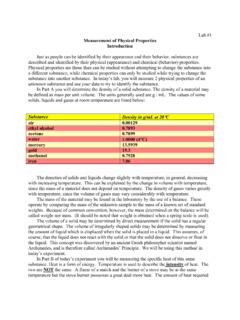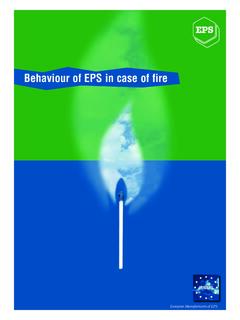Transcription of Polymer-Based Materials for Heat Exchangers
1 High Thermal Conductivity Polymer Composites for heat Recovery Technologies Evaluating low-cost options for non-metallic heat Exchangers A heat exchanger is a device typically used to efficiently transfer heat between one or more fluids. heat Exchangers are critical components of thermal systems widely used in industrial and commercial applications such as car radiators, heat pumps, refrigeration, and ambient cool-ing systems. Most heat Exchangers are constructed from metals such as copper and alumi-num that are subject to corrosion and corrosion-related failure during use. Metallic based systems pose manufactur-ing constraints including costly assembly processes. For example, designs such as the shell-tube and fan coil require significant manual labor during assembly.
2 heat Exchangers constructed of Polymer-Based Materials could offer an alternative to metallic heat Exchangers . The use of high thermal conductivity polymer com-posites in place of copper and aluminum could reduce Materials costs and overall manufacturing costs, and provide energy savings during manufacturing and end use. Polymer Materials could also reduce component weight, mitigate corrosion risks, and enable new innovative design options. This project will identify and evaluate commercially-available and state-of-the art Polymer-Based material options for manufacturing industrial and commercial non-metallic heat project team will identify and evalu-ate optimal filler material, shapes, and orientation to enhance polymer thermal conductivity.
3 Other relevant properties such as strength, fluid compatibility, permeability, and flammability will also be evaluated. The results will be pre-sented in a database of relevant material properties and characteristics to provide guidance for future heat exchanger for Our Industry and Our NationIncreased use of non-metallic heat Exchangers could reduce energy use and greenhouse gas emissions, and realize significant productivity benefits. For example, the manufacturing time for polymer composite heat exchang-ers is expected to be reduced by up to 90% compared to typical metallic heat Exchangers . Total Materials costs and overall manufacturing costs could be reduced by as much as 50%. These inno-vations will help keep the United States competitive in the global market.
4 Applications in Our Nation s IndustryHeat Exchangers are widely used in industry including at chemical plants, pet-rochemical plants, petroleum refineries, natural-gas processing, sewage treatment, and power stations. Commercial applica-tions include space heating, refrigeration, and air conditioning. The identification and evaluation of Polymer-Based heat recovery technologies with superior corrosion resistance will enable greater market adoption of affordable heat Exchangers , saving money and energy throughout the United DescriptionThe objective of this project is to identify, evaluate, and characterize composite Materials systems to enable the fabrica-tion of non-metallic heat Exchangers for industrial and commercial applications.
5 The project team will develop a heat exchanger concept and evaluate its performance with innovative heat transfer modeling tools. An aluminum heat exchanger with copper coils. An evaluation of existing Polymer-Based heat recovery technologies will provide guidance for future heat exchanger development. Image courtesy of MANUFACTURING OFFICEP olymer-Based Materials for heat ExchangersBarriers Plastic durability, including fatigue and leakage, is a concern. Thicker wall designs and barrier coating Materials should help mitigate this risk. Material costs could be higher than anticipated due to increased demand for plastics. PathwaysThe project team will review and compile a list of relevant material properties for several polymer composite Materials , both commercially available and in the development stage.
6 The Materials will be evaluated for thermal conductivity, permeability, life cycle cost, flammabil-ity, stability, and manufacturability. The project team will determine which Materials have properties that meet the requirements for integration into a high-performance heat exchanger . The evalu-ation will be based on published data. When not available, modeled or measured properties data will be used. The project team will also develop and validate modeling tools, and model validation will be carried out at material coupon levels. The project team will work closely with United Technologies Company s (UTC s) business units manufacturing building and aerospace applications to define requirements and estimate the impacts of a Polymer-Based heat exchanger in a range of applications.
7 The project team will conduct further research on material selection for the three most impacted applications. For one selected application and material system, they will develop a heat exchanger concept and evaluate its performance with the heat transfer model-ing tools. In addition, fabrication options will be proposed and a manufacturing risk assessment will be performed. MilestonesThis 18-month project began in December 2014. Review commercially-available and state-of-the-art composite Materials and compile their relevant properties through literature-based searches and consultation with experts in the field (Complete) Identify three potential applications to focus material selection on, based on market size and potential energy impact (Complete) Develop and validate modeling tools to predict the thermal conductivity and mechanical properties of composite Materials (2016) Test commercial samples to validate results and potential use in heat Exchangers (2016) Develop a heat exchanger concept for one application and evaluate its perfor-mance based on existing heat transfer modeling tools (2016)
8 CommercializationUnited Technologies Research Center (UTRC) will work with project part-ners two leading universities in the field to propose fabrication options. UTRC is the central research organization for United Technologies Corporation (UTC), the parent company to Carrier (air conditioning) and Pratt & Whitney (aircraft engines). UTRC has demon-strated experience in the development of technology and its commercialization, supporting the breadth of UTC s business units, as well as a substantial manufactur-ing footprint in the United States. Project PartnersUnited Technologies Research Center (UTRC), a United Technologies Company (UTC) East Hartford, CT Principal Investigator: Catherine Thibaud-Erkey Email: of Massachusetts, Lowell Lowell, MAUniversity of Akron Akron, OHFor additional information, please contactBob Gemmer Technology Manager Department of Energy Advanced Manufacturing Office Phone: (202) 586-5885 Email: ADVANCED MANUFACTURING OFFICEDOE/EE-1255 April 2016 For more information, visit.



















